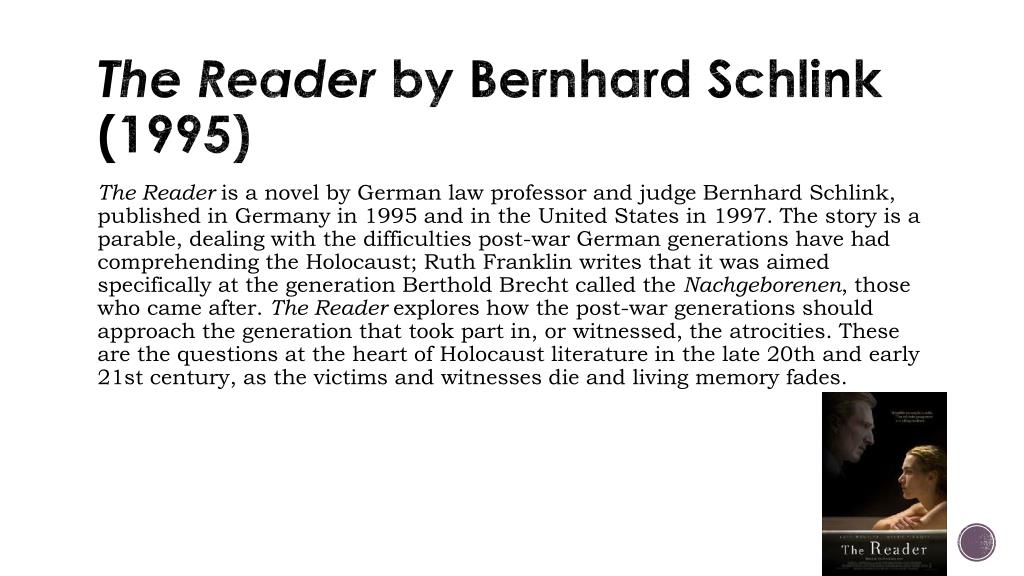
While the law regulates the behavior, it is morality that constrains the heart. Implication follows that duty and legality do not excuse wrongdoings. The law has nothing to do with right or wrong, he tells Michael. It may also be the weaker script, compared to the book, that has shrouded some critical issues with ambiguity.īut I did appreciate the scene where a distressed Michael consults with his professor (Bruno Ganz), who distinguishes between law and morality. Maybe due to his limited scenes, it appears that Fiennes lacks the time to dwell himself fully in the character to elicit the spectrum of conflicting emotions. Likewise, the portrayal of the older Michael (Ralph Fiennes) is less effective than it deserves.

#Summary of the reader by bernhard schlink movie#
The irony of the movie is that, by crafting a visually appealing cinematic offering, it has won over its viewers’ heart (especially Winslet fans), resulting in a much more sympathetic rendition of someone who has a hand in the death of hundreds of Jews under her guard. Winslet has brought out an exceptional performance, from a simple and passionate young woman to a grey-haired, seemingly amoral and yet deeply tormented prisoner. The love affair between Michael and Hanna is the very analogy of a younger generation having had to deal with the conflicting emotions of loving their own parents, many of whom were involved in the atrocities of the Nazi regime.īoth Winslet and Kross have delivered a most affective cinematic rendering of an otherwise despicable affair. However, having watched the movie I have also come to appreciate the necessity of this relationship. The first part of the movie depicting the seduction of Michael (18 year-old David Kross) by Hanna (Kate Winslet) and which gradually grows into a full-fledged love affair does carry some gratuitous erotic sequences. Further, the very complex moral issues the book deals with would be a challenge to transfer into film, making it less effective and maybe even trivializing the crux of the matter. First off, I could imagine the film, having the advantage of transporting the literary into visual realism, can go all out gratuitously to depict the love affair between Michael and Hanna. I read the book a while back but have delayed seeing the movie, directed by Stephen Daldry and screenplay by David Hare (both of The Hours, 2002). When I condemned it as it must be condemned, there was no room for understanding… it was impossible to do both.” “I wanted simultaneously to understand Hanna’s crime and to condemn it… When I tried to understand it, I had the feeling I was failing to condemn it as it must be condemned. The moral burden that Michael faces is heavy, seemingly unresolvable and yet born by the collective psyche: This is not a Holocaust novel, but rather, an incisive depiction of psychological dilemma confronting a new, post-war generation in Germany. Hidden behind the romantic facade is a story that deals with a deeply complex set of moral issues the love affair between a 30 some year-old woman and a 15 year-old boy is only the initial spark. The story wraps up with a heart-wrenching ending. Michael, now a lawyer, is still haunted by his past and the residual emotional ambivalence upon the release of Hanna from prison. The last part of the book is in the present day. Her only statement of defence is wrapped in one sentence: “What would you have done?” She asked the judge. As Michael is awash by torrents of conflicting emotions while watching the trial, he is aghast at a personal secret Hanna refuses to reveal, one which could have saved her from a lengthy prison term. Hanna turns out to be a guard at a concentration camp during the Holocaust.
#Summary of the reader by bernhard schlink trial#
Every time they meet, Hanna makes sure Michael reads to her literature from Homer to Chekhov.Īfter a while, Hanna disappears, and not until Michael becomes a law student does he see her again, this time in a post-war trial of Nazi criminals.

Thus sparks the sexual encounter and later love affair between the two. 15 year-old Michael Berg gets sick on his way home from school and is helped by a woman, Hanna Schmitz.

The first part takes place in the 1950’s. Selected as a New York Times Notable Book and a Los Angeles Times Book of the Year, the novel’s 218 pages are packed densely with poignant images and thought-provoking moral questions. Thus the poignant acknowledgement from Kate Winslet as she received her Oscar Best Actress Award. Their untimely death sadly altered the scene somewhat, even though they were still named as producers when the Awards Season arrived. Anthony Minghella (Cold Mountain, 2003) was said to be the original director of the film adaptation, with his friend Sydney Pollack ( Sketches of Frank Gehry, 2005) producing. It was first published in 1995 in Europe and the English translation came out two years later. The Reader is the highly acclaimed novel by German writer Bernhard Schlink.


 0 kommentar(er)
0 kommentar(er)
